Native Plants at the Oakton Trolley House
By Susan Stager, Fairfax Master Gardener Intern
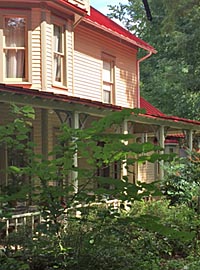 If you lived in the Oakton area at the turn of the century and into the 1930’s, and you needed to travel to DC, you might have taken the trolley. The 1905 Oakton Trolley house is now home to a gardener, Adrienne Stefan and her husband. Adrienne cultivates native plants, and I had the pleasure of touring her garden in September.
If you lived in the Oakton area at the turn of the century and into the 1930’s, and you needed to travel to DC, you might have taken the trolley. The 1905 Oakton Trolley house is now home to a gardener, Adrienne Stefan and her husband. Adrienne cultivates native plants, and I had the pleasure of touring her garden in September.
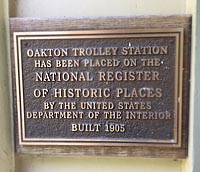 You can see where the train tracks would have run across the street. There are now turtleheads (Chelone obliqua, the pink ones) growing where the train would have gone. Turtleheads like a moist site, make nice cut flowers and are attractive to butterflies.
You can see where the train tracks would have run across the street. There are now turtleheads (Chelone obliqua, the pink ones) growing where the train would have gone. Turtleheads like a moist site, make nice cut flowers and are attractive to butterflies.
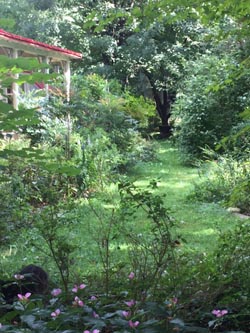 Jewelweed, (Impatiens capensis) an annual that reseeds itself, is planted in several spots. Here is a photo that shows how the plant got its common name. During the night the plant will expel excess water through a process called guttation. These beads of water form on the edge of the leaves and sparkle in the sunlight, like beads of jewelry. Like other impatiens, the flowers have a spur that holds nectar. This makes the flowers appealing to hummingbirds. Jewelweed is believed to help reduce the rash and itching from poison ivy.
Jewelweed, (Impatiens capensis) an annual that reseeds itself, is planted in several spots. Here is a photo that shows how the plant got its common name. During the night the plant will expel excess water through a process called guttation. These beads of water form on the edge of the leaves and sparkle in the sunlight, like beads of jewelry. Like other impatiens, the flowers have a spur that holds nectar. This makes the flowers appealing to hummingbirds. Jewelweed is believed to help reduce the rash and itching from poison ivy.
Several colors of green and silver leaves planted together make a nice effect without the traditional concept of color in a garden. “This silvery plant is wonderful for pollinators: mountain mint (Pycnanthemum virginianum.) A tough native to this area, bees just love it and it spreads (mint family) but not horribly,” explained Adrienne.
 I spotted a cranberry viburnum (Viburnum trilobum) along the fence, named for the large red berry it produces.
I spotted a cranberry viburnum (Viburnum trilobum) along the fence, named for the large red berry it produces.
You can imagine how passengers would pass through the double doors onto the porch and board the train.
I noticed that this gardener tolerates some holes in her hostas, as I do. She explained that she is “gardening for the critters,” and if there are bugs, it means birds will come and have something to eat. Birds of many varieties visit the bird houses and feeders scattered around the property. Her hostas produce fragrant jasmine scented flowers. In this photo, you can also see the hostas and purple ironweed (Vernonia noveboracensis.) “It planted itself a year ago. It’s a very welcome volunteer, and is beloved by butterflies and bees. It blooms in late summer through early autumn and is an east coast native,” said Adrienne.
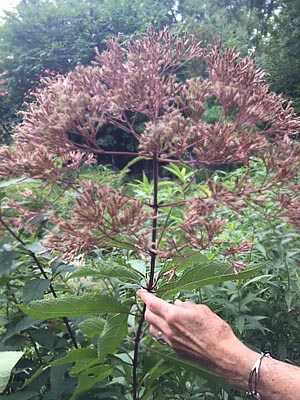
Joe Pye Weed
Although it is called Joe Pye weed, (Eupatorium fistulosum,) this plant produces an interesting flower whorl. This species often exceeds 6 feet in height.
I was fascinated with the orange color, “three-piece suit” effect of a black vest (soon to be wings) and three dapper black “buttons” on the Nymph Milkweed Bugs, Oncopeltus fasciatus. Milkweed is a primary monarch butterfly food source.
The property is a National Wildlife Federation Certified Wildlife Habitat, providing four basic habitat elements needed for wildlife to thrive: food, water, cover and places to raise young.
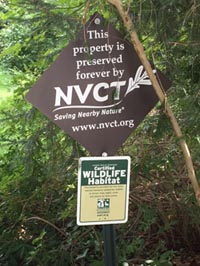 The property is also a conservation easement through NVCT, Northern Virginia Conservation Trust. Conservation easements are voluntary legal agreements that landowners enter to permanently restrict the uses of their land.
The property is also a conservation easement through NVCT, Northern Virginia Conservation Trust. Conservation easements are voluntary legal agreements that landowners enter to permanently restrict the uses of their land.
The tour of Adrienne’s garden was arranged through the Stewards of Creation group at Church of the Holy Comforter. This is a group of gardeners who are fans of native plants and who encouraged their cultivation in local gardens through their plant donations at the fall church fair.
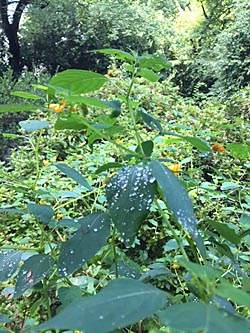 jewelweed |
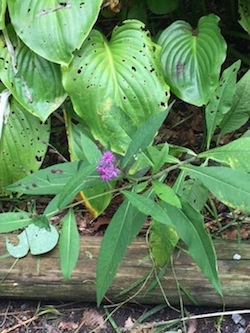 hosta & ironweed |
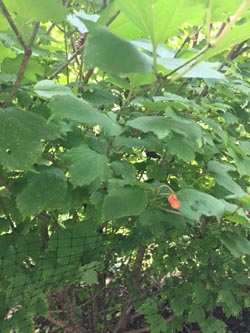 cranberry virburnum |
 mountain mint |
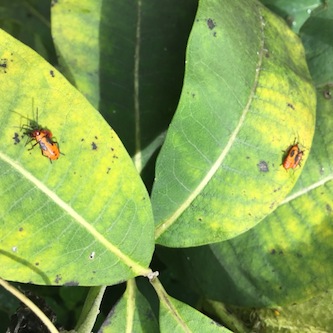 milkweed bug nymphs |
References
What is a Conservation Easement?, Northern Virginia Conservation Trust,
Family Agrees to Preserve Oakton Trolley Station, Oakton Patch, 3/5/2012
Garden for Wildlife Certification, National Wildlife Federation:
Turtleheads, Perennials.com
Jewelweed, A Native Jewel, Farmers and Consumers Market Bulletin, GA Dept. of Agriculture